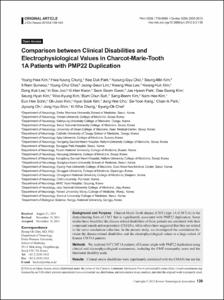Comparison between Clinical Disabilities and Electrophysiological Values in Charcot-Marie-Tooth 1A Patients with PMP22 Duplication
- Keimyung Author(s)
- Lim, Jeong Geun
- Department
- Dept. of Neurology (신경과학)
- Journal Title
- Journal of Clinical Neurology
- Issued Date
- 2012
- Volume
- 8
- Issue
- 2
- Keyword
- charcot-marie-tooth disease; CMT1A; compound muscle action potential; duplication; nerve conduction velocity; sensory nerve action potential
- Abstract
- Background and Purpose: Charcot-Marie-Tooth disease (CMT) type 1A (CMT1A) is the demyelinating form of CMT that is significantly associated with PMP22 duplication. Some studies have found that the disease-related disabilities of these patients are correlated with their compound muscle action potentials (CMAPs), while others have suggested that they are related to the nerve conduction velocities. In the present study, we investigated the correlations between the disease-related disabilities and the electrophysiological values in a large cohort of Korean CMT1A patients.
Methods: We analyzed 167 CMT1A patients of Korean origin with PMP22 duplication using clinical and electrophysiological assessments, including the CMT neuropathy score and the functional disability scale.
Results: Clinical motor disabilities were significantly correlated with the CMAPs but not the remotor
nerve conduction velocities (MNCVs). Moreover, the observed sensory impairments matched the corresponding reductions in the sensory nerve action potentials (SNAPs) but not with slowing of the sensory nerve conduction velocities (SNCVs). In addition, CMAPs were strongly correlated with the disease duration but not with the age at onset. The terminal latency index did not differ between CMT1A patients and healthy controls.
Conclusions: In CMT1A patients, disease-related disabilities such as muscle wasting and sensory impairment were strongly correlated with CMAPs and SNAPs but not with the MNCVs or SNCVs. Therefore, we suggest that the clinical disabilities of CMT patients are determined by the extent of axonal dysfunction.
- Keimyung Author(s)(Kor)
- 임정근
- Publisher
- School of Medicine
- Citation
- Young Hwa Kim et al. (2012). Comparison between Clinical Disabilities and Electrophysiological Values in Charcot-Marie-Tooth 1A Patients with PMP22 Duplication. Journal of Clinical Neurology, 8(2), 139–145. doi: 10.3988/jcn.2012.8.2.139
- Type
- Article
- ISSN
- 1738-6586
- Appears in Collections:
- 1. School of Medicine (의과대학) > Dept. of Neurology (신경과학)
- 파일 목록
-
-
Download
 oak-aaa-2370.pdf
기타 데이터 / 593.94 kB / Adobe PDF
oak-aaa-2370.pdf
기타 데이터 / 593.94 kB / Adobe PDF
-
Items in Repository are protected by copyright, with all rights reserved, unless otherwise indicated.